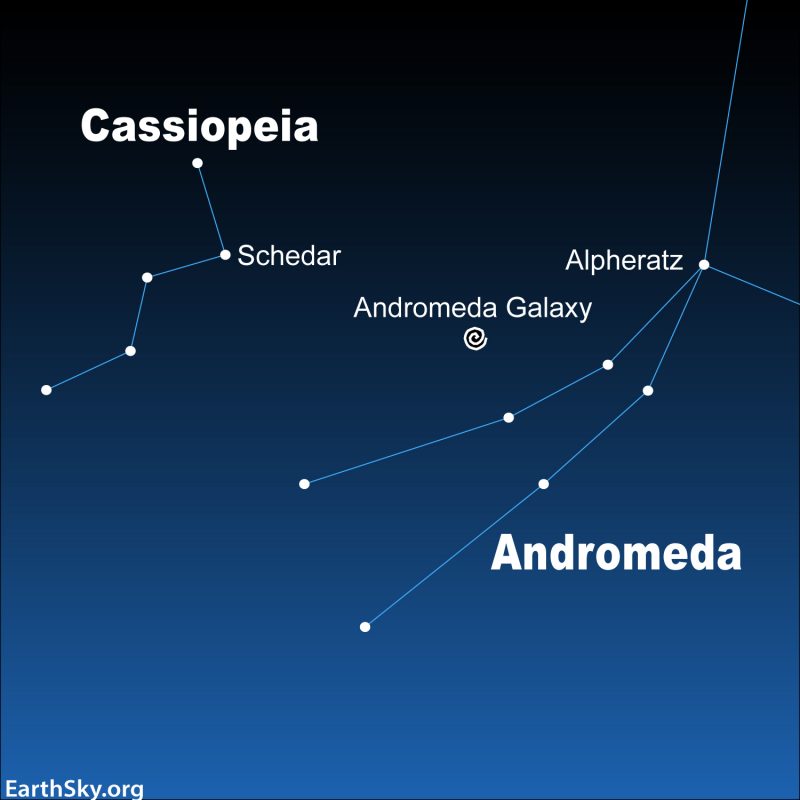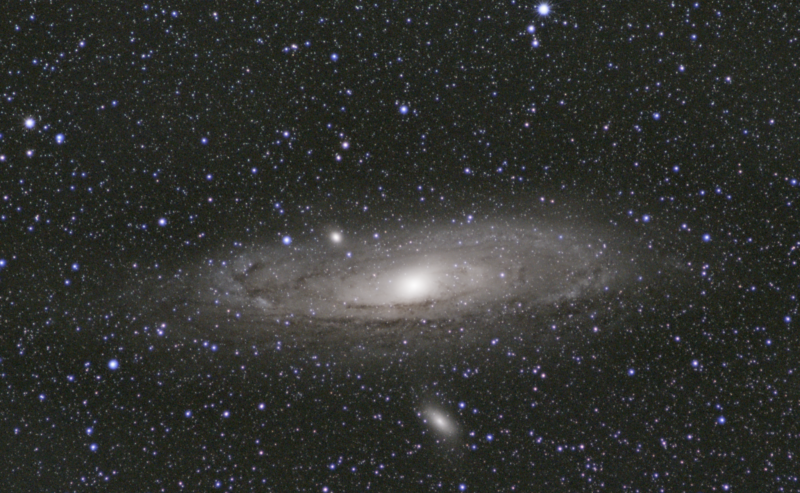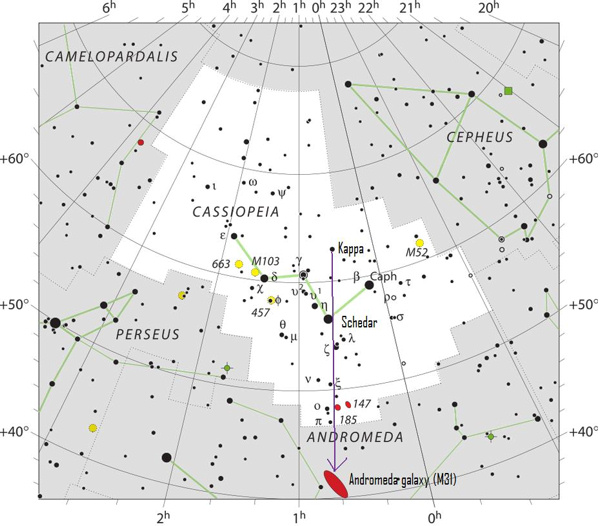
The Andromeda galaxy
The Andromeda galaxy is the nearest large spiral galaxy to our Milky Way. It’s about 2.5 million light-years away, teeming with hundreds of billions of stars. In fact, it’s considered the farthest object you can see with the unaided eye.
Read more: The Andromeda galaxy: All you need to know
Use Cassiopeia to find the Andromeda galaxy
Tonight, if you have a dark sky, try star-hopping to the Andromeda galaxy from the constellation Cassiopeia the Queen. If your sky is dark, you might even spot this hazy patch of light with no optical aid, as the ancient stargazers did before the days of city lights.
But what if you aren’t under a dark sky, and you can’t find the Andromeda galaxy with the eyes alone? Well, some stargazers use binoculars and star-hop to the Andromeda galaxy via this W – or M-shaped constellation.
Cassiopeia appears in the northeast sky at nightfall and early evening, then swings upward as evening deepens into late night. Then in the wee hours before dawn, Cassiopeia is found high over Polaris, the North Star. Note that one half of the W is more deeply notched than the other half. This deeper V is your “arrow” in the sky, pointing to the Andromeda galaxy.

Finder chart for the Andromeda galaxy

Binoculars enhance the view
Binoculars are an excellent choice for beginners to observe the Andromeda galaxy, because they are so easy to point. As you stand beneath a dark sky, locate the galaxy with your eye first. Then slowly bring the binoculars up to your eyes so that the galaxy comes into binocular view. If that doesn’t work for you, try sweeping the area with your binoculars. Go slowly, and be sure your eyes are dark-adapted. The galaxy will appear as a fuzzy patch to the eye. Naturally, it’ll appear brighter in binoculars. And can you see its central region is brighter and more concentrated?
But remember, with the eye, binoculars, or with a backyard telescope, the Andromeda galaxy won’t look like the images from famous telescopes and observatories. But it will be beautiful. Plus, it’ll take your breath away. And just think, you’re looking at a galaxy over 2 million light-years away. Wow!
Bottom line: You can find the Andromeda galaxy using the constellation Cassiopeia as a guide. Remember, on a dark night, this galaxy will look like a faint smudge of light. And once you’ve found it with the unaided eye or binoculars, look at it with a telescope if you have one.
Read more: Andromeda galaxy: Find it by star-hopping from Pegasus
Read more: Andromeda galaxy stuns in new images and sounds!
The post Find the Andromeda galaxy using Cassiopeia first appeared on EarthSky.
from EarthSky https://ift.tt/7MKqNIS

The Andromeda galaxy
The Andromeda galaxy is the nearest large spiral galaxy to our Milky Way. It’s about 2.5 million light-years away, teeming with hundreds of billions of stars. In fact, it’s considered the farthest object you can see with the unaided eye.
Read more: The Andromeda galaxy: All you need to know
Use Cassiopeia to find the Andromeda galaxy
Tonight, if you have a dark sky, try star-hopping to the Andromeda galaxy from the constellation Cassiopeia the Queen. If your sky is dark, you might even spot this hazy patch of light with no optical aid, as the ancient stargazers did before the days of city lights.
But what if you aren’t under a dark sky, and you can’t find the Andromeda galaxy with the eyes alone? Well, some stargazers use binoculars and star-hop to the Andromeda galaxy via this W – or M-shaped constellation.
Cassiopeia appears in the northeast sky at nightfall and early evening, then swings upward as evening deepens into late night. Then in the wee hours before dawn, Cassiopeia is found high over Polaris, the North Star. Note that one half of the W is more deeply notched than the other half. This deeper V is your “arrow” in the sky, pointing to the Andromeda galaxy.

Finder chart for the Andromeda galaxy

Binoculars enhance the view
Binoculars are an excellent choice for beginners to observe the Andromeda galaxy, because they are so easy to point. As you stand beneath a dark sky, locate the galaxy with your eye first. Then slowly bring the binoculars up to your eyes so that the galaxy comes into binocular view. If that doesn’t work for you, try sweeping the area with your binoculars. Go slowly, and be sure your eyes are dark-adapted. The galaxy will appear as a fuzzy patch to the eye. Naturally, it’ll appear brighter in binoculars. And can you see its central region is brighter and more concentrated?
But remember, with the eye, binoculars, or with a backyard telescope, the Andromeda galaxy won’t look like the images from famous telescopes and observatories. But it will be beautiful. Plus, it’ll take your breath away. And just think, you’re looking at a galaxy over 2 million light-years away. Wow!
Bottom line: You can find the Andromeda galaxy using the constellation Cassiopeia as a guide. Remember, on a dark night, this galaxy will look like a faint smudge of light. And once you’ve found it with the unaided eye or binoculars, look at it with a telescope if you have one.
Read more: Andromeda galaxy: Find it by star-hopping from Pegasus
Read more: Andromeda galaxy stuns in new images and sounds!
The post Find the Andromeda galaxy using Cassiopeia first appeared on EarthSky.
from EarthSky https://ift.tt/7MKqNIS

Aucun commentaire:
Enregistrer un commentaire